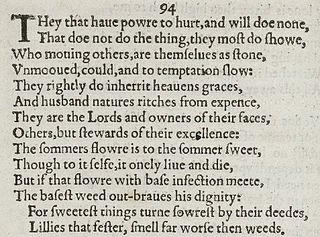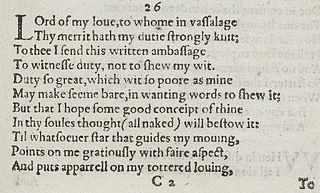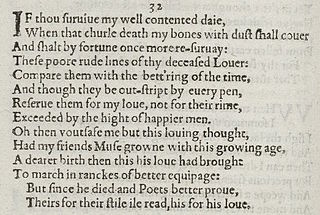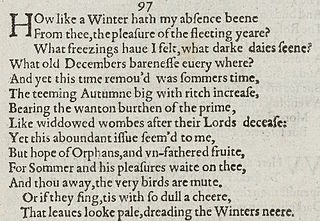| Sonnet 105 | |||||||
|---|---|---|---|---|---|---|---|
 Sonnet 105 in the 1609 Quarto | |||||||
| | |||||||
| |||||||
Sonnet 105 is one of 154 sonnets written by the English playwright and poet William Shakespeare. It is a member of the Fair Youth sequence, in which the poet expresses his love towards a young man.
| Sonnet 105 | |||||||
|---|---|---|---|---|---|---|---|
 Sonnet 105 in the 1609 Quarto | |||||||
| | |||||||
| |||||||
Sonnet 105 is one of 154 sonnets written by the English playwright and poet William Shakespeare. It is a member of the Fair Youth sequence, in which the poet expresses his love towards a young man.
The poet denies that his love is a form of idolatry and that the youth himself is an idol. He insists that he has been constantly devoted to the values of fairness, kindness and truth. Being three themes united in the figure of the youth, there is great scope for verse, since they have never been united in one person before.
The language used is similar in some respects to the language in the Book of Common Prayer used to describe the Holy Trinity, and Shakespeare's triple repetition of the three attributes of the Fair Youth - "Three themes in one" - makes plain his deliberate comparison of the youth to a form of deity or idol, even as he purports not to engage in idolatry (in the sense of polytheistic worship of idols).
Sonnet 105 is an English or Shakespearean sonnet. The English sonnet has three quatrains, followed by a final rhyming couplet. It follows the typical rhyme scheme of the form ABAB CDCD EFEF GG and is composed in iambic pentameter, a type of poetic metre based on five pairs of metrically weak/strong syllabic positions. The 3rd line exemplifies a regular iambic pentameter:
× / × / × / × / × / Since all alike my songs and praises be (105.3)
The sonnet embraces a large number of stresses in normally non-stressed positions. These appear as inversions and non-ictic stresses, both of which appear in line 10:
× / × / / × × / × / Fair, kind, and true, varying to other words; (105.10)
Here, both "fair" and "kind" are fully stressed, but in a regular reading only "kind" is metrically marked, "fair" being a non-ictic stress. In contrast, "varying" (which the meter demands function as two syllables [2] ) is a mid-line inversion. Both variations recur several times in this sonnet.
Sonnet 105 falls broadly into the group of Sonnets addressed to a "Fair Youth", which ranges from Sonnets 1-126. This group of sonnets address an unnamed youth who acted as the object of Shakespeare's love. The nature of that love has often been debated, namely whether it was romantic or platonic in nature, The consensus is generally that they are more romantic in nature, judging by the classic romantic language used in Sonnets like the famous 18th ("shall I compare thee to a Summer's day"), and the poet's lamentation that the youth was not born a woman in Sonnet 20. The youth's identity is also often disputed, and his true identity is not known for certain. However, one of the more probable candidates is that of Henry Wriothesley, the Earl of Southampton. This theory states that the Earl, one of Shakespeare's patrons, became the subject of Shakespeare's love, and the majority of the Sonnets are addressed to him. More specifically, Sonnet 105 occupies a group of sonnets within the Fair Youth sequence, from 97 to 105, that seem to indicate happiness at the return of Shakespeare's love, the addressee. In the group prior to this, the poet expressed sadness at his muse's extended absence. It appears, however, that the Fair Youth's return yielded a happier series of poems, in which Shakespeare describes the return of his muse and speaks of the youth with "a lighter heart, and once more exalts his virtues, truth and constancy" [3] For historians like Massey, the sonnet is mainly an honest expression of happiness and joy at the chance to return to the lofty romance language that defined his more melancholy period.
Religious themes are also prevalent in this sonnet. The sonnets were published in 1609, composed during the reign of Queen Elizabeth I, who re-instituted The Anglican Church in England. One of the tenets of Protestantism was the belief that Catholic practices of worshiping the multitude of Saints and the Virgin Mary were practices of idolatry and were henceforth blasphemous. [4] Hence, Shakespeare's claim against idolatry indicates his love is always directed at the same youth. Other interpretations make the claim that the religious nature of the poem is ironic, that Shakespeare is well aware that the love he describes is indeed idolatry. Scholar Jane Roessner states that "the speaker seems done with all efforts to persuade; now the sonnets are set up at once to deceive and reveal: to appear to be genuine praises ... while in fact covertly revealing the corruption of the friend, and ultimately, of the sonnets themselves which had at first seemed to be stays against corruption". [5] Thus, the purpose behind the sonnet is one of intentional double standards. In addition, Shakespeare is playing with the religious perversity, using the Christian imagery as a way of describing his love.
Sonnet 105 invokes a strongly religious tone and is read by most critics as decidedly Christian, as it denies claims of idolatry and strongly alludes to the trinity. In his analysis, Brian Gibbons emphasizes the importance of the speaker's denial of idolatry; the speaker is following the first two commandments by practicing monotheism and not building any other idols or images. However, the speaker fundamentally breaks the Third Commandment by taking the name of the Lord in vain; "unorthodox monotheism is in Christian terms blasphemous." Gibbons views this oversight on the part of the poet as convenient and intentional rather than accidental. [6]
Like Gibbons, Eugene Wright views this sonnet with a Christian lens, noting that the poet uses familiar Christian rhetoric and imagery to appeal to the reader. However, he argues that the speaker is not guilty of blasphemy because it is not the youth being praised, but the "qualities of 'Fair, kind, and true,' transcendent qualities the young man partakes of." According to Wright, the main idea of the poem is unity - the unity of the three qualities in the persona, never before seen in a strictly mortal man. The emphasis on three-in-one is not meant to replace the trinity or suggest that the beloved is divine or equivalent to Christ, but to echo the unity of the virtues and to evoke an image of perfection. [7]
Carl Atkins' analysis undermines some of the more popular interpretations of this sonnet, largely because he emphasizes the possibility that the poet and the male beloved (or "Fair Youth") had a passionate but platonic friendship, devoid of sexual tension. Like Wright and Gibbons, Atkins picks up on the Christian imagery and emphasis on "fair, kind, and true" throughout the poem. However, he reads this sonnet through a more secular lens and stresses the speaker's love for his friend more than the poem's religious tone. The repetition of "fair, kind, and true" serve as a kind of method for making the beloved embody those virtues in the speaker's mind, if not in actuality. He defends this argument by pointing out the several preceding sonnets in which the beloved is distinctly not fair, kind, or true. Atkins' criticism also focuses on the illogicality of the speaker considering his love to be monotheistic and not idolatrous. He argues that the claim of a monotheism is "a very poor counter to an accusation of idolatry." The speaker in fact practices idolatry by praising his beloved as if the friend were a deity. [8]

Sonnet 94 is one of 154 sonnets written by the English playwright and poet William Shakespeare. It is a member of the Fair Youth sequence, in which the poet expresses his love towards a young man.

Sonnet 8 is one of 154 sonnets written by the English playwright and poet William Shakespeare. It is a procreation sonnet within the Fair Youth sequence. As with the other procreation sonnets, it urges a young man to settle down with a wife and to have children. It insists a family is the key to living a harmonious, peaceful life.
Sonnet 29 is one of 154 sonnets written by the English playwright and poet William Shakespeare. It is part of the Fair Youth sequence. In the sonnet, the speaker bemoans his status as an outcast and failure but feels better upon thinking of his beloved. Sonnet 29 is written in the typical Shakespearean sonnet form, having 14 lines of iambic pentameter ending in a rhymed couplet.

Sonnet 15 is one of 154 sonnets written by the English playwright and poet William Shakespeare. It forms a diptych with Sonnet 16, as Sonnet 16 starts with "But...", and is thus fully part of the procreation sonnets, even though it does not contain an encouragement to procreate. The sonnet is within the Fair Youth sequence.

Sonnet 21 is one of 154 sonnets written by the English playwright and poet William Shakespeare and is part of the Fair Youth sequence. Like Sonnet 130, it addresses the issue of truth in love, as the speaker asserts that his lines, while less extravagant than those of other poets, are more truthful. Contrary to most of Shakespeare's sonnets, Sonnet 21 is not addressed to any one person. There is no second person, no overt "you" or "thou" expressed in it.

Sonnet 26 is one of 154 sonnets written by the English playwright and poet William Shakespeare, and is a part of the Fair Youth sequence.

Sonnet 32 is one of 154 sonnets written by the English playwright and poet William Shakespeare. It is a member of the Fair Youth sequence, in which the poet expresses his love towards a young man. The writer is reflecting on a future in which the young man will probably outlive him. The writer takes a melancholy tone, telling the young man to remember the writer not because of the strength of the sonnets, but because the love that has been shown to the young man far surpasses any love shown by another poet.
Sonnet 41 is one of 154 sonnets written by the English playwright and poet William Shakespeare. It is a part of the Fair Youth section of the sonnets addressed to an unnamed young man. While the exact date of the composition is unknown, it was originally published in the 1609 Quarto along with the rest of the sonnets.

Sonnet 42 is one of 154 sonnets written by the English playwright and poet William Shakespeare. It is a part of the Fair Youth section of the sonnets addressed to an unnamed young man.

Sonnet 138 is one of the most famous of William Shakespeare's sonnets. Making use of frequent puns, it shows an understanding of the nature of truth and flattery in romantic relationships. The poem has also been argued to be biographical: many scholars have suggested Shakespeare used the poem to discuss his frustrating relationship with the Dark Lady, a frequent subject of many of the sonnets. The poem emphasizes the effects of age and the associated deterioration of beauty, and its effect on a sexual or romantic relationship.

Sonnet 57 is one of 154 sonnets written by the English playwright and poet William Shakespeare. It is a member of the Fair Youth sequence, in which the poet expresses his love towards a young man. Sonnet 57 is connected with Sonnet 58 which pursues the theme of the poet as a slave of the beloved.

Sonnet 62 is one of 154 sonnets written by the English playwright and poet William Shakespeare. It is a member of the Fair Youth sequence, addressed to the young man with whom Shakespeare shares an intimate but tormented connection. This sonnet brings together a number of themes that run through the cycle: the speaker's awareness of social and other differences between him and the beloved; the power and limitations of poetic art; and the puzzling sense in which love erases the boundaries between individuals.

Sonnet 64 is one of 154 sonnets written by the English playwright and poet William Shakespeare. It is a member of the Fair Youth sequence, in which the poet expresses his love towards a young man.

Sonnet 67 is one of 154 sonnets written by the English playwright and poet William Shakespeare. It's a member of the Fair Youth sequence, in which the poet expresses his love towards a young man and is a thematic continuation of Sonnet 66. In this poem, the speaker's anxiety about the social difference between him and his beloved takes the form of a criticism of courtly corruption. This sonnet was placed first in the pirated and mangled edition of 1640.

Sonnet 97 is one of 154 sonnets written by the English playwright and poet William Shakespeare. It is a member of the Fair Youth sequence, in which the poet expresses his love towards a young man. It is the first of three sonnets describing a separation between the speaker and the beloved.

Sonnet 71 is one of 154 sonnets written by the English playwright and poet William Shakespeare. It's a member of the Fair Youth sequence, in which the poet expresses his love towards a young man. It focuses on the speaker's aging and impending death in relation to his young lover.

Sonnet 70 is one of 154 sonnets written by the English playwright and poet William Shakespeare. It is a member of the Fair Youth sequence, in which the poet expresses his love towards a young man.

Sonnet 72 is one of 154 sonnets published by the English playwright and poet William Shakespeare in 1609. It is one of the Fair Youth Sequence, which includes Sonnet 1 through Sonnet 126.

Sonnet 107 is one of 154 sonnets written by the English playwright and poet William Shakespeare. It is a member of the Fair Youth sequence, in which the poet expresses his love towards a young man.
Sonnet 113 is one of 154 sonnets written by the English playwright and poet William Shakespeare. It's a member of the Fair Youth sequence, in which the poet expresses his love towards a young man.